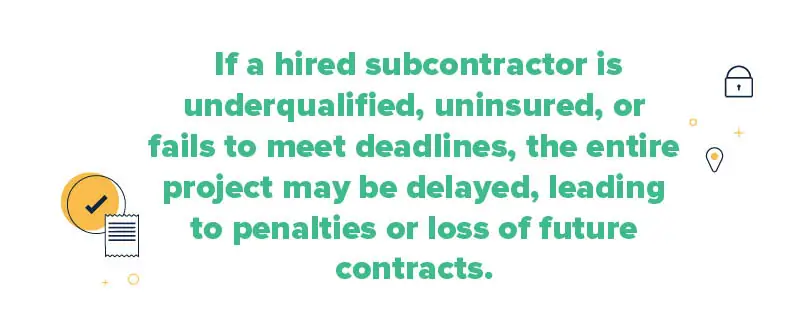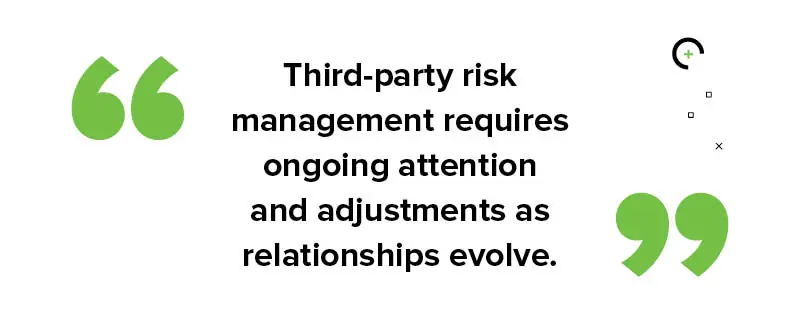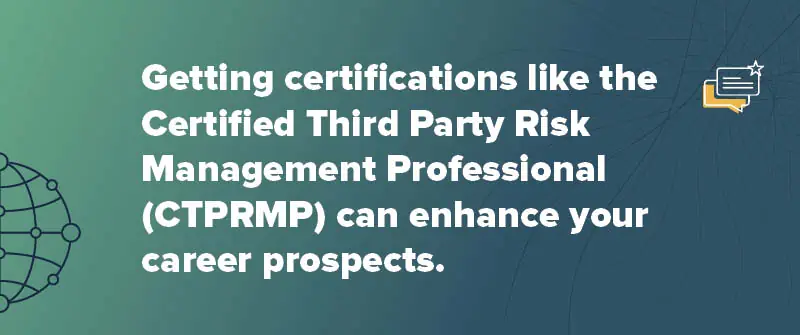
In today’s interconnected business world, organizations are working with more external partners, vendors, and suppliers than ever before. These third-party relationships help bring cost savings, efficiency, and access to specialized expertise to their partners. However, along with the many benefits comes a set of risks that must be carefully managed. That’s where third-party risk management (TPRM) strategies come into play.
Simply put, third-party risk management is all about identifying, assessing, and reducing the risks that your business faces when working with partners and external vendors. These risks can come in all shapes and sizes – financial, reputational, operational, and more. A strong third-party risk management framework is essential for keeping your business protected from various vulnerabilities in order to mitigate risk.
In this article, we’ll break down the key components of an effective TPRM strategy, consider real-world examples that are both successful and not, talk about the importance of mitigating risks and strategies for doing so, and explore how investing in third-party management technology and tools like certificate of insurance services can help protect your business.
What Are Third-Party Management Examples?
Third-party risk management (TPRM) has evolved significantly over the past few decades. It started as a reactive approach to managing vendor-related issues but has now shifted toward a more proactive and strategic model. As businesses become more reliant on external partners, TPRM practices have incorporated technology, regulatory frameworks, and continuous monitoring to stay ahead of risks, providing more comprehensive protection than ever before.
To better understand third-party risk management, it can be helpful to consider how different industries face unique risks when working with external partners. Let’s walk through a few scenarios across sectors that demonstrate the potential pitfalls that can come along with inadequate risk management.
Third-Party Management in Healthcare
Hospitals sometimes outsource their IT services and data storage to third-party providers. If a chosen provider had weak cybersecurity measures, patient data could be compromised, leading to major privacy violations and regulatory penalties. An example of this, unfortunately, occurred in 2019 when the American Medical Collection Agency had a data breach that exposed the health data of over 21 million Americans.
Third-Party Management in Financial Services
Banks often collaborate with payment processors or cloud service providers. If these third parties lack robust security protocols, they can expose the bank to data breaches and corresponding regulatory fines.
A well-known case of this involved Global Payments Inc., a third-party processor, which experienced a breach compromising over 1 million credit card numbers, costing both the processor and its financial institution clients millions of dollars.
Third-Party Management in Manufacturing
Businesses that source parts from domestic or overseas suppliers should be wary of potential violations of environmental or labor laws from their vendors. Even damage indirectly done, like those caused by third parties, trickles down and could hurt the reputation and bottom line of the hiring party.
Construction companies often work with subcontractors who bring specific expertise to a project – as well as an additional level of risk. If a hired subcontractor is underqualified, uninsured, or fails to meet deadlines, the entire project may be delayed, leading to penalties or loss of future contracts. Protect what you’ve built with contractors general liability insurance.

Examples of Successful Third-Party Management
As these examples illustrate, third-party risk is an important consideration across all sectors. Each industry has its unique challenges, and effective TPRM helps ensure that organizations maintain their integrity and operational security.
A successful TPRM strategy can be difficult to spot because, when it’s working well, the absence of issues or disruptions can signal its effectiveness. In a way, the best sign of a strong risk management process is that you don’t hear about it. Let’s walk through a few examples of effective applications of TPRM.
- JP Morgan: In 2014, JP Morgan Chase, one of the largest global financial institutions, faced blowback after several data breaches. The company overhauled its third-party risk management strategy, implementing stricter vendor vetting processes and continuous cybersecurity monitoring. By investing in enhancing its TPRM framework, JP Morgan was able to avoid subsequent breaches, rebuild trust with clients, and protect its customer data going forward.
- Siemens: Siemens, a popular technology and manufacturing company, implemented a robust TPRM program after several of its suppliers failed to meet compliance standards. They started using automated risk assessments and periodic audits to ensure vendor accountability. As a result, the company mitigated compliance risks and reduced costly project delays caused by underperforming vendors.
Mitigating Third-Party Risk
While understanding the importance of TPRM is crucial, knowing how to mitigate third-party risks effectively is equally vital. So, how can businesses begin developing strategies to reduce these risks and ensure that their partnerships stay secure?
A multifaceted approach is essential when mitigating third-party risks. Companies should take several steps throughout a project’s timeline to ensure that they stay protected.
An important first step is to conduct thorough due diligence before entering into any new partnership. This involves evaluating the financial health, cybersecurity practices, regulatory compliance, and more of all potential partners.
Another important technique here is risk segmentation. Not all third parties pose the same level of threat, so it’s helpful to adopt a risk-based approach that prioritizes attention to relationships that are most likely to significantly impact your organization. Creating contingency plans can also be extremely helpful. For example, if a third party insurance verification company were to fail to meet its obligations, having backup suppliers or stricter contract terms could help mitigate potential disruptions.
Finally, TPRM is not a set-it-and-forget-it strategy. Continuous monitoring is vital. Regularly reviewing third-party relationships ensures that they are meeting your expectations and compliance standards. Maintaining clear communication with vendors about those expectations is also crucial for preserving strong business relationships.
The Process of Third-Party Risk Management
There are several key steps involved in building an effective third-party risk management process. It generally involves the following stages: identifying third-party relationships, assessing various levels of risk, reducing those risks through contractual protections or insurance requirements, and conducting ongoing monitoring. Let’s walk through how a business should start to think about its vendor risk management efforts.
Identify Third-party Relationships
Create a complete list of all external partners, such as contractors, suppliers, and other vendors within your organization, to gain full visibility over potential risks. Whether they provide IT services, legal advice, raw supplies, or physical labor, make sure they are accounted for within all of the relevant teams and systems in your organization. Failing to do so can leave gaps in risk oversight, especially when departments don’t communicate their dependencies on partners well internally.
Organize partners based on the kinds of services they provide and whether they are integral or accessory to your business. For more advanced strategizing, ensure that your inventory captures indirect connections (i.e., your vendors’ vendors), as risks can leak down through these networks. Building this foundation is crucial for understanding your full risk exposure and establishing an effective management strategy.

Assess Various Levels of Risk
Next, you’ll need to evaluate the risk associated with each third party. Consider all kinds of risks, whether financial, cybersecurity, operational, reputational, or related to regulatory or contractual. You can also take into account things like their years of experience, level of professionalism, reputation, and customer reviews.
A comprehensive risk assessment procedure is essential because risks often extend beyond the obvious. For example, vendors with poor internal processes can create weak links in your own security and operational success. By taking a multidimensional approach to risk assessment, companies can more accurately prioritize which vendors need closer attention.
Many companies use risk assessment tools and questionnaires to determine the level of risk posed by a third party. Whatever methods you rely on, ensure that you’re using both qualitative and quantitative measures to evaluate risk. So, in addition to metrics and numerical scores, consider things like feedback from the internal teams who interact with the vendor and any historical performance issues they may have encountered.
Reduce Risk as Much as Possible
Develop strategies to mitigate identified risks, such as including security clauses in contracts and requiring proof of insurance coverage upfront before a vendor can begin working with you.
One of the most effective ways to manage risk is by negotiating strong contracts with third parties. Consider including specific clauses that can help protect your business within your contracts, such as indemnification clauses, limitation of liability clauses, service level agreements (SLAs), security clauses, and more.
Another crucial step to reducing risk is confirming adequate third-party insurance protections. Ensure that your vendors have the appropriate coverage, such as general liability insurance. This is where certificates of insurance services become vital, as they help track whether your vendors are maintaining the necessary coverage throughout the life of the contract.
Conduct Ongoing Monitoring and a Vendor Risk Management Program
Third-party risk management requires ongoing attention and adjustments as relationships evolve. Even after a third party is onboarded, their risk profile may change over time due to factors like new regulations, business growth, or changes in the global economy. Establish a process for continuous monitoring of third-party relationships to adapt to any changes in risk levels.
Continually monitor third-party performance against contractual obligations, SLAs, and compliance standards. If a vendor fails to meet agreed-upon standards, address the issue promptly to avoid future disruptions, liabilities, or lawsuits.
Additionally, set a schedule for conducting periodic audits of your third parties. Regular audits also show that your company takes risk management seriously, which can boost customer, partner, and shareholder confidence in your business.

Technology’s Role in Third-Party Risk Assessment and Risk Mitigation
Technology plays an increasingly important role in managing third-party risks, helping businesses automate many parts of the risk management process that we outlined above. Third-party risk management software can streamline the entire process and help teams avoid common and costly human errors.
These platforms offer tools that help businesses organize their vendor relationships, assess risks based on factors like financial stability or compliance status, and continuously track any changes.
Platforms like ServiceNow enable businesses to automate risk assessments, monitor third parties in real time, and ensure compliance. With strong systems like these in place, companies can significantly reduce the complexity and manual effort involved in managing vendor risks.
Implementing Third-party Risk Management Software
Implementing third-party risk management software can be a game changer for businesses looking to improve and streamline their risk management processes. These platforms come equipped with a variety of tools and techniques that help companies manage third-party relationships more efficiently and effectively.
One of the key features of TPRM software is automated risk assessments, which allow businesses to evaluate vendor risks based on a range of factors like their financial stability, cybersecurity measures, and compliance with regulations. These platforms can also enable real-time monitoring and alert systems, allowing organizations to stay on top of any changes in their vendors’ risk profiles, such as new regulatory violations or lapses in insurance coverage.
When implementing a TPRM software solution, businesses should first ensure that it integrates well with their existing vendor management systems. You should also customize the platform based on your company’s unique needs, whether it’s creating tailored risk assessment questionnaires, setting up automated workflows, prioritizing vendors based on their level of risk exposure, etc.
Finally, businesses must train their teams on how to properly use new systems and ensure that risk reports, insurance certificates, and compliance documents are updated regularly. Over time, software helps teams reduce manual effort, ensure continuous monitoring, and encourage proactive risk mitigation, leading to a more secure and successful business operation.
Third-Party Risk in Anti-Money Laundering (AML)
In the context of compliance, another important concept is understanding how third-party risk interplays with anti-money laundering (AML) regulations. Third-party risk in AML refers to the potential for your external partners to intentionally or unintentionally engage in activities that could facilitate money laundering. For example, a financial institution may work with third-party payment processors. If those processors fail to comply with AML regulations, the bank could be held liable for any associated violations.
Managing third-party risk in AML requires a combination of strong and consistent compliance processes and meticulous monitoring. Financial institutions often conduct enhanced due diligence on their third-party vendors to ensure they are not involved in any suspicious activities.
Many organizations utilize software to track transactions and flag any unusual patterns that could indicate money laundering. Failure to manage these risks can result in large fines and reputational damage, so businesses must take AML-related third-party risks seriously.
Career and Certification in Third-Party Risk Management
As companies increasingly prioritize TPRM, the demand for qualified professionals in this field is on the rise. For individuals interested in pursuing third-party risk management, there are multiple career options and probably more to come. Currently, positions range from Third-Party Risk Analysts to Third-Party Risk Managers and even Chief Risk Officers for larger organizations.
To build a successful career in this field, there are, of course, a few helpful skills and qualifications one can hold. Getting certifications like the Certified Third Party Risk Management Professional (CTPRMP) can enhance your career prospects. Courses that focus on risk management within specific industries, such as manufacturing or finance, as we mentioned above, are also helpful in providing some of the specialized knowledge that’s in high demand.

Other skills often helpful to professional development in third-party risk management include:
- Risk assessment and analysis
- Customer service and vendor relationship management
- Detail-orientedness
- Knowledge of regulatory compliance
- Cybersecurity awareness
- Legal knowledge
- Project management
- Financial literacy
- Problem-solving
How COI Services Can Help You Manage Third-Party Risks
As we’ve discussed, effective third-party risk management is vital for organizations navigating today’s complex business landscape. By implementing a strong framework, leveraging technology, and prioritizing continuous monitoring, businesses can safeguard their interests while maintaining mutually beneficial relationships with external partners.
If your organization is serious about mitigating third-party risks and enhancing operational security, consider utilizing certificate of insurance services as part of your overall risk management strategy. COI services provide verification of insurance coverage for your third-party vendors, ensuring compliance and reducing liability. This type of tracking not only strengthens your third-party risk management processes but also offers peace of mind by ensuring that vendors are adequately insured.
Want more information on TPRM? Book a demo today to see how our COI services can support your organization’s third-party risk management framework and help you mitigate potential risks.
Need more help with learning about Third-Party Risks? You’re in the right place. Reach out to us today to learn how myCOI can support you.